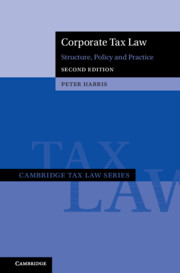Book contents
- Corporate Tax Law
- Cambridge Tax Law Series
- Corporate Tax Law
- Copyright page
- Contents
- Preface
- Abbreviations
- Introduction
- 1 Taxation of Corporate Income When Derived
- 2 Taxation of Corporate Income When Distributed
- 3 Taxation of Corporate Income
- 4 Creating Share Interests
- 5 Transferring Share Interests
- 6 Terminating Share Interests
- 7 Varying Share Interests
- 8 Dividend and Capital Stripping and Value Shifting
- References
8 - Dividend and Capital Stripping and Value Shifting
Published online by Cambridge University Press: 29 February 2024
- Corporate Tax Law
- Cambridge Tax Law Series
- Corporate Tax Law
- Copyright page
- Contents
- Preface
- Abbreviations
- Introduction
- 1 Taxation of Corporate Income When Derived
- 2 Taxation of Corporate Income When Distributed
- 3 Taxation of Corporate Income
- 4 Creating Share Interests
- 5 Transferring Share Interests
- 6 Terminating Share Interests
- 7 Varying Share Interests
- 8 Dividend and Capital Stripping and Value Shifting
- References
Summary
This final chapter considers the reverse of Chapter 7. Here there might be no realisation event with respect to shares, but the shareholder’s interest may be considered to have changed sufficiently in substance to justify tax consequences. This chapter focuses on the interplay between dividend taxation and taxation on the disposal of shares. If those taxations are not similar and capital gains treatment is preferred, taxpayers might attempt to convert dividends into capital gains such as by disposing of the right to receive dividends or disposing of shares cum-dividend. If capital gains treatment is not preferred, there may be an attempt to strip value out of shares before disposal either directly by attacking rights in shares or indirectly by taking value out of a corporation. This is referred to as value shifting. Finally, if different types of shareholders have different preferences, then they might try to arbitrage their tax treatments by combining dividend disposal and capital stripping. This can happen with stock lending and share repurchase agreements but can also be a feature of abusive full dividend stripping.
Keywords
- Type
- Chapter
- Information
- Corporate Tax LawStructure, Policy and Practice, pp. 613 - 637Publisher: Cambridge University PressPrint publication year: 2024

